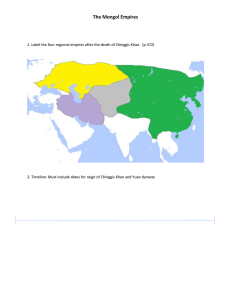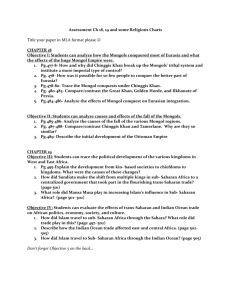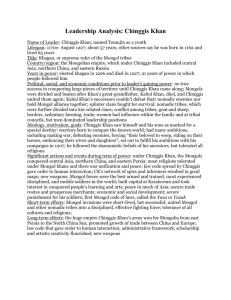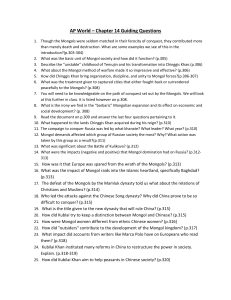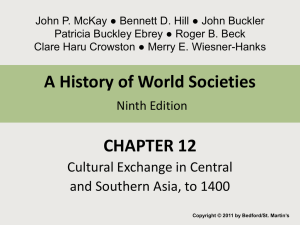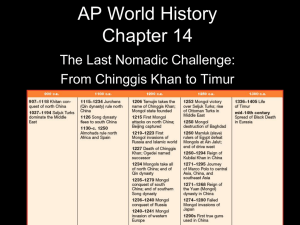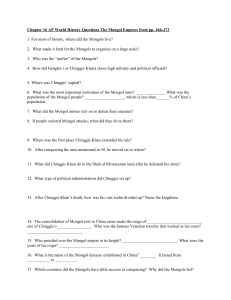Validation by Holiness or Sovereignty: Religious Toleration as
advertisement
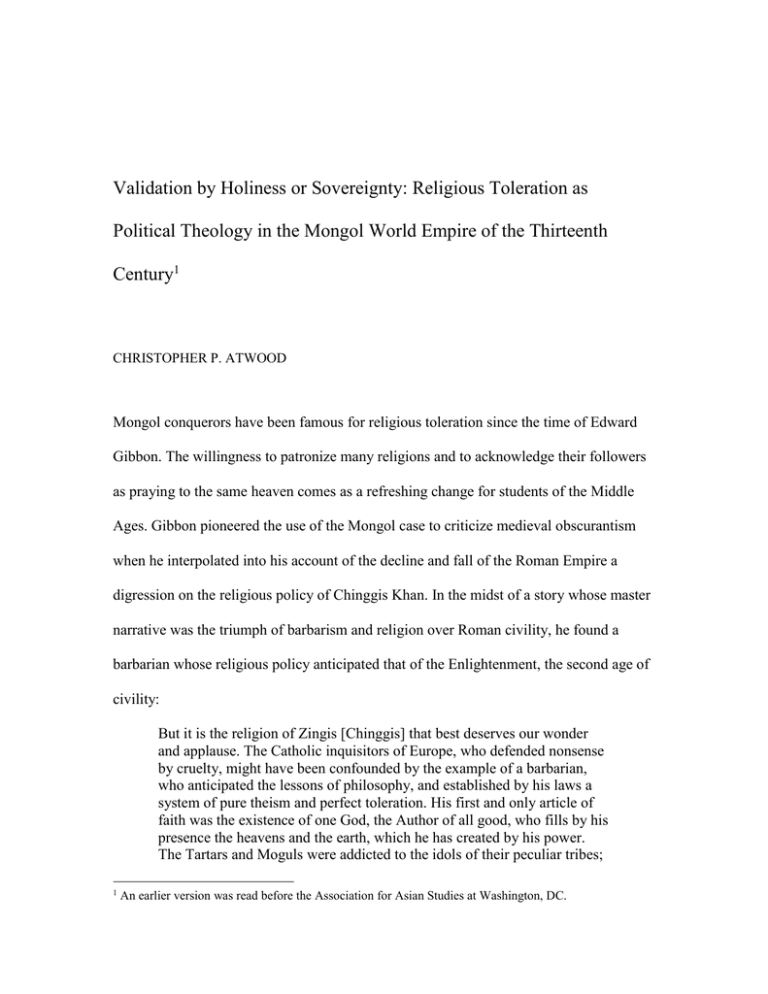
Validation by Holiness or Sovereignty: Religious Toleration as Political Theology in the Mongol World Empire of the Thirteenth Century1 CHRISTOPHER P. ATWOOD Mongol conquerors have been famous for religious toleration since the time of Edward Gibbon. The willingness to patronize many religions and to acknowledge their followers as praying to the same heaven comes as a refreshing change for students of the Middle Ages. Gibbon pioneered the use of the Mongol case to criticize medieval obscurantism when he interpolated into his account of the decline and fall of the Roman Empire a digression on the religious policy of Chinggis Khan. In the midst of a story whose master narrative was the triumph of barbarism and religion over Roman civility, he found a barbarian whose religious policy anticipated that of the Enlightenment, the second age of civility: But it is the religion of Zingis [Chinggis] that best deserves our wonder and applause. The Catholic inquisitors of Europe, who defended nonsense by cruelty, might have been confounded by the example of a barbarian, who anticipated the lessons of philosophy, and established by his laws a system of pure theism and perfect toleration. His first and only article of faith was the existence of one God, the Author of all good, who fills by his presence the heavens and the earth, which he has created by his power. The Tartars and Moguls were addicted to the idols of their peculiar tribes; 1 An earlier version was read before the Association for Asian Studies at Washington, DC. and many of them had been converted by the foreign missionaries to the religions of Moses, of Mohammed, and of Christ. These various systems in freedom and concord were taught and practised within the precincts of the same camp; and the Bonze, the Imam, the Rabbi, the Nestorian, and the Latin priest, enjoyed the same honorable exemption for service and tribute: in the mosque of Bochara the insolent victor might trample the Koran under his horse’s feet, but the calm legislator respected the prophets and pontiffs of the most hostile sects. The reason of Zingis was not informed by books: the khan could neither read nor write; and except the tribe of the Igours, the greatest part of the Moguls and Tartars were as illiterate as their sovereign.2 Yet Gibbon, by noting in the footnote to this passage, that ‘a singular conformity may be found between the religious laws of Zingis Khan and of Mr Locke,’ first took the historical short cut that treats Mongol religious policy only as a curious foreshadowing of the Enlightenment. In reaction to Gibbon’s implausible claim, scholars such as David O. Morgan conclude: ‘Toleration there certainly was, but it was determined not so much by high-mindedness as by indifference, by a feeling that any religion might be right and that therefore it would be sensible to have every subject praying for the khan.’3 Given the tendency to frame the issue as one of whether the Mongols were or were not as high-minded as John Locke, the origins of Mongol religious policy and its significance within contemporary religious ideas have, not surprisingly, been ignored. In fact, neither tolerance nor indifference and scepticism, played any part. Mongol religious policy was based on a series of assertions about heaven’s (or God’s) role in human affairs that added up to a coherent political theology. Religions that contradicted it were ignored, if beyond reach, or ruthlessly suppressed, if within. ***** 2 3 E. Gibbon, Decline and Fall of the Roman Empire (1776-88; rpt. New York, 1977), iii. 625-6. D. Morgan, The Mongols (Oxford, 1986), p. 41. 2 The answer to the questions whether the Mongols had a religious policy and, if so, in what spheres did it operate and how long did it last, is found in documents that demonstrate an identical religious policy being applied, in both fourteenth-century China and among the fourteenth-century Golden Horde, by rulers who adhered personally to Buddhism or Islam. Comparison of the extant ’Phags-pa script documents granting religious exemptions dating from 1271 to 1368 with decrees granting exemptions to the Russian church dating from 1267 to 1357, and extant in medieval Russian translation, reveals a similarity in form that points to a common model. Each of the decrees begins with an invocation, the famous formula: ‘By the power of eternal Heaven, By the fortune of the Qa’an’ or ‘By the power of eternal Heaven, By the protection of the great and glorious fortune’. Second, it announces who is speaking: ‘Word of ours the Qa’an’, and so on. Third, it lists those to whom the decree is addressed, a list that always includes darugha(chi)s (Turkish basqaq) or overseers, military commanders, and envoys. The lists resemble those in other Mongol documents and often include members of the Mongol royal entourage who frequented the countryside (for example, leopardists and falconers) as well as post-road personnel of various types. Fourth, the decree explains the reason for the exemption: that Chinggis and his successors, sometimes listed by name, sometimes not, have decreed that all priests shall be exempt from tribute and tax but, in return, shall pray to God for the khan and his family and bless them. Fifth, it states that, accordingly, the current prince or khan will confirm this exemption for some particular high-level cleric. Sixth, it lists all of the Mongol officials and paiza (tablet) holders who are not to collect provisions or taxes from the specified religious establishment, and all of the cleric’s subordinates to whom the decree applies. Seventh, it issues a threat against 3 anyone who contravenes its terms. (The Yuan decrees alone contain a further threat against clerics who take advantage of the exemption to behave in an unseemly fashion.) Eighth, and last, it states the date on which and place at which it was issued.41 The best way to exemplify the similarity is to compare an edict of Ayurbarwada (titled Renzong or Buyantu Qa’an) to a Daoist temple, dated to 1314, and a decree of Berdi Beg (r. 1357-9) to Aleksey, the metropolitan of the Orthodox Church in Russia.5 Edict of Ayurbarwada Decree of Berdi Beg I. By the power of eternal Heaven, By the I. By the power and grandeur of the protection of the great and glorious Immortal God since [Our] fathers and fortune. grandfathers. II. Decree of ours, the Qa’an. II. The word of Berdebek. By the suggestion [i.e., memorial] of Mulabuga. III. A Decree to instruct the officers of the III. To the Tatar, the Ulus, and the army, the people of the army, the Military Princes, to [their] own district darughas and the officials of the cities, governors. And to the princes, and the and the messengers traveling to and fro. scribes, and seal [-toll] men, and [river] bank [control] men, and the passing To date, thirty-eight mostly complete Yuan-era exemption decrees in the ’Phags-pa script have been published. Thirty-five from China and Tibet closely follow the format outlined here. See D. Tomortogoo, Mongol dörwöljin üsegiin duraskhalyn sudalgaa: udirdkhal, ekh bichig, ügsiin khelkhee, nomzüi (Ulaanbaatar, 2002). For an English translation with texts of some of the earlier-discovered decrees, see Mongolian Monuments in the ḥP’ags-pa Script, ed. N. Poppe and J. R. Krueger (Wiesbaden, 1957), pp. 4655 and H. F. Schurmann, ‘Mongol Tributary Practices of the Thirteenth Century’, Harvard Journal of Asiatic Studies, xix (1956), 346-48. 5 Translation of Ayurbarwada's edict by the author based on the text in Mongolian Monuments, ed. Poppe, pp. 48-9; translation of Berdi Beg's edict by Schurmann, 'Mongol Tributary Practices', pp. 347-8. 4 4 envoys and the falconers, and the leopardists, and the buralozhniki,6 and the post [guards], and the boat men, or whomsoever proceed on whatever task, to the multitude, and to all. IV. In the decrees of Chinggis Qa’an, IV. The Emperor Cin-giz [Chinggis] and Ögödei Qa’an, Sechen Qa’an, Öljeyitü subsequent emperors, our fathers, and for Qa’an, and Külüg Qa’an,7 it is said that whom prayer-men and the entire caste of the Buddhist monks, the Christians, and priests prayed, [decreed]: the xianshengs [Daoist priests] shall not ‘Whatever tribute there be, or custom, it is be subject to any duties or payments, but not necessary for them to observe it, so shall pray to God and give blessings. that they may invoke God in peace and repeat the prayer.’ So saying they granted the yarlyks. And whosoever it might be, all [of the emperors?], having known this, granted the yarlyks. V. And now according to the previous V. And now, We, not changing the yarlyks decrees a letter which they are to keep has of the original emperors, having thought Possibly related to Turkish borla tamgasï, ‘vineyard seal[-toll]’. Sechen Khan is the Mongolian temple name of Qubilai (r. 1260-94), Öljeyitü is the temple name of Temür (r. 1294-1307), and Külüg is that of Haishan (1307-11). Ayurbarwada (temple name, Buyantu Khan) was the brother of Haishan, and reigned 1311-20. 6 7 5 been given to the xianshengs in the [this] out, in the same [way] have Daizhongyang-Wanshou-Gong8 and its favoured the Metropolitan Aleksey, [and xiayuan-gongguans9 in Fengyuanlu, state]: saying they shall not being subject to any ‘As [he is] seated in Volodimir, prays to duties or payment, but shall pray to God god for Us and Our tribe, and recites the and give blessings. prayer, So we have spoken: VI. Messengers shall not stay in their VI. ‘Whatever tribute there may be, or gongguans, anmiaos,104 or chambers, nor custom, they shall not take [such] from shall they get post-horses or meat, nor them; nor vehicle[s], nor comestibles, nor shall the commercial tax (tamqa) be paid. food, nor levies, nor honouring (?), they None, whoever they may be, shall use shall not give [such], force against any land or water, people or ‘Or whatever church [possessions]: horses, gardens or mills, dians or shops, homes, waters, gardens, vineyards, mills, jiediankus or baths, fas115 or boats or carts they shall not take them [away] from or anything else belonging to the them, nor do any violence upon them. gongguans, or against the water rights of ‘And whosoever has taken anything, or any of the three areas, Meibei, Gan, and whosoever takes anything, let them give it Lao, or against the mountain of Ganyu. back. And in their church houses, Nor shall they seize them for themselves whosoever it be, let them not establish and take them away. themselves therein, nor destroy them. ‘Palace of the Heaviest Yang with a Life of Ten-Thousand Years’: name of a Daoist temple. Xiayuan: ‘Lower court’ (Chinese term for subordinate temples under the jurisdiction of a larger one); Gongguan: general term for Daoist temples. 10 Anmiao: shrine, temple, monastery. 11 Dian: ‘inn’; hedianku: ‘pawn-shop’; fa: ‘ferry’ (for fording rivers). 8 9 6 VII. [As this has been said, shall not VII. But whosoever should establish people who nullify it be afraid?]12 himself [therein] or destroy them, they shall be in sin and shall die. ‘And thou, Aleksey the Metropolitan, and all your priestly caste shall repeat that we (i.e., the Metropolitan and the priests) have been thus favored. Indeed, whatever Thou dost through customary [law] unto church, houses, lands, waters, gardens, vineyards, or through church people, that is up to Thee. Or whosoever commit whatever [kind of] evil deed by thievery, murder, [and] lie, Thou shouldst not look upon it, but Thou thyself shalt know how to make rectification thereon. And pray for Us to God. Henceforth Thou [art] the leader, and we shall say nothing [about] that.’ VIII. They too shall not do things that are VIII.(Absent) not right, claiming that they have a decree. If they do so, shall it not be them who are 12 The threat against violators, a standard component of Mongolian jarliqs, is missing from several otherwise typical Yuan religious jarliqs. Here I add the text from the yizhi (decree of an empress) of Empress Dowager Targi to the Daoist temples in Baoding. See Mongolian Monuments, ed. Poppe, pp. 54-5. 7 afraid? IX. Our Decree. IX. So we have spoken. We have given to Written on the twenty-eight day of the you the paiza and the yarlyk with the first moon of autumn of the tiger year crimson seal as confirmation. while at Chaga’an Cang. [Written] in the year of the hen [=1357], the tenth month, in [the year] 708, in the month of Sylgat, on the tenth of the new [third of the moon]. And the court was nomadizing on the Kaonga.13 There is a note following this: ‘It was written. Mulabuga, Usyain, Yagaltai,Kutlubuga, and the leading princes have presented a petition. Seunch Temir Myur Bakshi has written [this yarlyk]’ is a usual chancellery form devised under Qubilai Khan and first attested in the Il-khanate under Geikhatu (1291-5). See F. W. Cleaves, ‘A Chancellery Practice of the Mongols’, Harvard Journal of Asiatic Studies, xiv (1951), 493-526; A. Soudavar, Art of the Persian Courts: Selections from the Art and History Trust Collection (New York, 1992), pp. 34-5, and C. P. Atwood, ‘Ulus Emirs, Seals, Marriage Partners, and Keshig Shifts: The Evolution of a Classic Mongol Institution’, Ninth Annual Central Eurasian Studies Conference, Bloomington, Indiana. 13 8 The decrees form a subset of the genre of Mongol chancellery documents traditionally called darqan jarliqs (Uighur: tarqan yarlïq). Sections I, II, III, VI, VII, VIII, and IX resemble similar decrees of exemption given to ortoqs (partner merchants) and aristocrats. What distinguishes these decrees are sections IV and V, which mention the history of and the justification for granting exemptions to religious figures. They declare that, first, the exemptions were initially granted by Chinggis Khan and continued by his successors; second, the exemptions were granted to various religions, not only one; and third, the exemptions were in return for the priests’ prayers for the khan. The list containing the widest range of religions granted exemption first appears in a decree of Prince Manggala, Qubilai Khan’s third son: ‘In the decrees of Chinggis Khan and of Qa’an [that is, Ögedei, r. 1229-41], it is said that the Buddhist monks (toyid), the Christian priests (ereke’üd), the Daoist priests (xiansheng-üd), and the Muslim clergy (dashmad) shall not be subject to any duties or payments (alba qubchiri).’ This formula is repeated in eight other Chinese decrees from the reigns of Qubilai (r. 1260- 94), Yisün-Temür (r. 1323-8), and ToghanTemür (r. 1333-70). Other examples from 1298 to 1368 list only the first three, omitting the Muslim clergy. Similar decrees of exemption for the Russian church list, in the first case, ‘priests and monks’, and in the second, ‘prayer-men and the entire caste of priests [who] prayed [for the khan]’. The Persian historian Juvaini, in reporting the coronation decrees of Möngke Khan (r. 1251-9), reports that he renewed the decrees that exempted from taxation those who ‘were exempt from the inconvenience of contributions by the ordinance of Chingiz-Khan [Chinggis Khan] and Qa’an, that is of the Moslems, the great sayyids and the excellent imams, of the Christians, whom they call erke’ün, the monks and scholars (ahbar) and of the idolators the priests whom they call toyin, the famous 9 toyins.’14 Here Daoists are merged with Buddhist toyins, as was common in Christian and Muslim writers of the Middle Ages, but that Möngke in fact separated Buddhists from Daoists is evident from the Chinese version of his decrees: ‘The monk Haiyun was put in charge of the affairs of the religion of Shakyamuni Buddha, and the Daoist priest Li Zhenchang was put in charge of the affairs of the religion of the Dao.’15 The list of the four favoured religions in Manggala’s decree echoes the form in which the Yuan shi lists the four groups of exempted clergy of the empire. In 1264, for example, decrees curtailing clerical tax exemptions list, in one case, yelikewun/erke’ün (Christian priests), dashiman (Muslim clergy), seng (Buddhist monks), and dao (Daoist priests) and, in the other, ru (Confucians), shi (Buddhist monks), dao (Daoists), erke’ün (Christian priests), and dashiman (Muslim clergy).16 Leaving aside for the moment the question of Confucians, the Yuan materials make clear that the list of religions, whose tax exemption was believed to date back to the time of Chinggis Khan, contained only four names: Buddhism, Christianity, Daoism, and Islam. In individual decrees, however, only religions practised locally are mentioned; thus, Manggala, ruling in north-west China, includes Muslims (in which religion his son was raised); Juvaini, writing in Persian, mentions Muslims, Christians, and Buddhists; and the decrees in Russian mention only Christians, or more vaguely, ‘the entire caste of priests’. ***** Actually, there seems to be no mention in the sources of any decree by Chinggis Khan specifying the four religions together as being exempt as members of a class of praying 14 'Ala-ad-Din 'Ata-Malik Juvaini, History of the World Conqueror, trans. J. Andrew Boyle (Cambridge, 1958), ii. 599. 15 Song Lian, Yuan shi (1370; rpt. Beijing, 1976), i. 45. 16 Song Lian, Yuan shi, i. 95. 10 religions. Rather, a series of separate decisions taken by Chinggis during his conquest of Uighuristan, North China, and Turkestan were treated after his death as a coherent whole. The change to listing four religions began at the coronation of his son Ögedei in 1229. The darqan jarliqs and the Yuan shi lists contain a striking omission: they make no mention of native Mongolian shamans (bo’e; Turkish qam), even though Chinggis and his successors kept a large staff of shamans at court headed by the chief shaman or beki.17 Mongol religion was put in a different category from foreign religions. Characteristically, Möngke appointed Aqcha as chief shaman during a reorganization of the support staff at court, while he had appointed new heads of the Daoist and Buddhist religions during a reorganization of generals and officials in the lands with sedentary populations: North China, the Central Asian oases, and the Middle East.18 Moreover, no document links the shamans to the clergy of other religions or specifies that the one had been granted the exemptions granted to the other. The list of the beki’s privileges in the famous Mongolian chronicle Secret History of the Mongols (c.1252) does not include the title of darqan or tax-exempt.194 Thus, Chinggis’s religious policy was devised during the encounter with non-Mongol religions during the period of conquest after 1209, not before. Chinggis first came into contact with followers of other religions surprisingly early, long before his first conquest of a sedentary people. In 1203, he promised by the Baljuna Covenant to share future wealth with his adherents in the way that they were sharing present woe with him. Among them were Chinqai, a Christian; Jabar and Hasan, both Muslim (the former was a sayyid or descendant of Muhammad); and two Kitans, Yelü Tuhua and Yelü Ahai, who 17 Secret History of the Mongols, trans. F. W. Cleaves (Cambridge, 1982), pp. 216, 272; Song Lian, Yuan shi, i. 46, 54. 18 Song Lian, Yuan shi, i. 45, 46. 19 Cleaves, Secret History of the Mongols, p. 216. 11 presumably were Buddhist.20 Between 1203 and 1205, he conquered the Kereyids and Naiman, and allied with the Onggüds, all of whom, especially the Onggüds, practised Christianity as the state religion. The native Mongol historical accounts, as embodied in the Secret History of the Mongols and the Veritable Records of Sarman from 1280, preserved in Rashid-ud-Din and the Shengwu qinzheng lu, are our only extensive sources on the period before 1211.21 They make no mention of foreign religions. The first evidence for the proclamation of clerical privileges dates from ten years later. The earliest encounter between Chinggis Khan and a foreign cleric is recorded for the year 1214 in the life of Haiyun the Buddhist priest in the Fozu lidai tongzai, a collection of biographies of the Chinese Buddhist patriarchs collected by Nian Chang (b. 1282) and arranged chronologically. Even though Chinggis probably could not have met Haiyun at this time - he appears to have left North China for Mongolia during that year - one of his sons probably did meet him.22 The meeting itself was short; supposedly Chinggis told the eighteen-year-old novice Zen monk to let his hair grow and arrange it in the Mongol style. When he replied: ‘If I were to follow the dynastic (that is, Mongol) customs, then I would lose the marks of a (Buddhist) monk,’ Chinggis allowed him to keep his head shaven, a privilege later granted to all monks.23 The supposed meeting took place at a time when the Mongols compelled ordinary Chinese to adopt the partially shaven Mongol hairstyle; the desire to escape this shame is said to have filled up Daoist temples, in which priests F. W. Cleaves, ‘The Historicity of the Baljuna Covenant’, Harvard Journal of Asiatic Studies, xviii (1955), 396-402. 21 On the Veritable Records of Sarman and their relation to Rashid-ud-Din’s Compendium of Chronicles and the Shengwu qinzheng lu, see T. T. Allsen, Culture and Conquest in Mongol Eurasia (Cambridge, 2001), pp. 96-7. 22 See Jan Yüan-hua, ‘Chinese Buddhism in Ta-tu: The New situation and New Problems’, in Yüan Thought: Chinese Thought and Religion under the Mongols, ed. Hok-lam Chan and W. T. de Bary (New York, 1982), p. 385. 23 Shi Nianchang, Fozu lidai tongzai (1341; rpt. Taipei, 1972), ch. 21, 8r-v; repr. as item 2036 of Taishō Shinshū Daizōkyō, ed. J. Takakusu and K. Watanage (1927; rpt. Tokyo, 1964), xlix. 701. 20 12 had the right to keep their heads unshaven.24 The encounter indicates that Buddhist monks were the first known foreign religious group to be recognized by the nascent Mongol dynasty. A similar story appears in the brief biography by Jingzhu (1601-54) of the Dhyana (Zen)Confucian scholar, Yelü Chucai, who joined Chinggis Khan’s entourage in 1215. By this account, as Chinggis was preparing his expedition against Khorazm in 1219, the local authorities sought to conscript able-bodied monks at the sacred mountain of Wutai Shan to augment the Mongol army. Yelü Chucai protested that as not killing was one of the Buddha’s strictest rules, monks willing to violate it would prove disloyal also to their king. Chinggis accepted the argument:25 the exemption from Mongol customs is again predicated on the monks’ loyalty to the founder of their order. An episode from 1219 first related in the Fozu lidai tongzai records - explained, in Chinggis’s own words, what he sought from the clergy. As his viceroy, Muqali, was pacifying Haiyun’s Shanxi homeland, one of Muqali’s Chinese generals, impressed with Haiyun and his master Zhongguan’s demeanour, recommended them to Muqali. Muqali then reported on the two to Chinggis, who issued the following decree on their behalf: ‘They truly are men who pray to Heaven (shi shigao Tiande ren). I should like to support them with clothes and food and make them chiefs. I’m planning on gathering many of this kind of people. [While] praying to Heaven, they should not have difficulties imposed on them. To forbid 24 Peng Daya and Xu Ting, Hei Da zhilue (1237), in Menggu shiliao sizhong, ed. Wang Guowei (1926; rpt. Taipei, 1962), p. 495r (p. i6r). See also. I. de Rachewiltz, ‘“The Hsi-yu Lu” by Yeh-lü Ch'u-ts’ai’, Monumenta Serica, xxi (1962), 32. The Mongols shaved the crown of their heads, leaving a forelock at the front and braided pigtails at the back. Buddhist monks shaved their heads completely, while Daoist priests did not shave their heads at all. 25 Jingzhu, Wudeng huiyuan xulue, repr. in Xu Zangjing, vol. 138 (Tokyo, 1881-5; repr. Hong Kong, 1968), juan 1, pp. 431r-v. 13 any bullying, they will be authorized to act as darqan?’26 A well-defined Turco-Mongol institution, the status of darqan not only offered exemption from taxes but also the right to use the post roads to move freely through the realm, and to requisition supplies, accommodation, and other necessities from the locals. The precondition for this grant of darqan is neither recognition of the right of conscience, generalized tolerance, nor sceptical reinsurance. Rather, it is the conviction, the result of a meeting or recommendation, that Haiyun and Zhongguan prayed to Heaven truly. Chinggis seems not to have been thinking about categories, Buddhism or Daoism, but solely of ‘this kind of people’ (na ban ren), presumably including all those who truly pray to Heaven. His edict recognizes individual, charismatic sanctity; it assumes that Heaven is moved by some prayers and not by others. Four years later, in 1223, Chinggis Khan issued his famous invitation to the Daoist Complete Realization patriarch, Changchun or Qiu Chuji, to visit his court in Afghanistan. After their meeting, Chinggis, convinced of Qiu Chuji’s holiness, exempted him and his disciples from all taxes.27 The exemption is specifically related to the efficacy of Qiu Chuji’s prayers and blessing: ‘they bless the Emperor with ten thousand upon ten thousand years of life, and that is why it is forbidden to force on them any requisitions or taxes great or small.’28 The impression that Chinggis Khan was not thinking in terms of defined religious communities is strengthened by the language of the decrees, which does not distinguish between Daoism and Buddhism. Qiu Chuji’s disciples are described as those who ‘daily recite the sacred books (niansong jingwen) and pray to Heaven (gao Tian)’. In fact, the Chinese scribes who drafted the decrees used Shi Nianchang, Fozu lidai tongzai, ch. 21, 9b; repr. in Taishō Shinshū Daizōkyō, item 2036, p. 703. See Li Chih-ch'ang, Travels of an Alchemist, trans. A. Waley (London, 1931; rpt. New York, 1979), esp. pp. 100-19. 28 E. Chavannes, ‘Inscriptions et pièces de chancellerie chinoise de l’époque mongole’, T’oung Pao, series 2, v (1904), 368-9. 26 27 14 mostly Buddhist terms to describe the religious life: xingxiu (practising conduct), chujia (leaving the world), and zhuchi (abbot); the word Dao, or xiansheng, is never used.29 As a result, Qiu Chuji and his disciples were able, without greatly distorting the meaning, to represent the edicts as granting them jurisdiction over everyone who had ‘left the world’, Buddhists included, causing a long-standing quarrel between Buddhism and Daoism. Again, the language expresses neither toleration nor scepticism, but a belief in the charismatic powers of certain groups of men to move Heaven with prayer. When one turns to the Western religions, Christianity and Islam, there is no record of an encounter between Chinggis Khan and a Christian holy man, despite his contact with known Christians by 1203, nor of a specific encounter with Islam, despite the more detailed record of his dealings with Muslims. Although the Muslim states of Qayaligh and Almaligh voluntarily acknowledged Mongol suzerainty in 1211, the first recorded official Mongol notice of Islamic worship came in 1217, when Jebe invaded Qara-Khitai, in the region of Kashghar and Khotan. Its last ruler had persecuted Muslim clerics, forcing them to embrace either Christianity or Buddhism (‘idolatry’) or to adopt Qara-Khitai dress. According to Juvaini, when the Mongols invaded, they ‘permitted the recitation of the takbir [glorification of God] and the azan [call to prayer], and caused a herald to proclaim in the town that each should abide by his own religion and follow his own creed’.30 This proclamation is the first recorded Mongol decree explicitly granting various religions the right to practise. The motive was political: to secure acquiescence from the native population. Nor were exemptions granted. The policy of allowing various religions to practise freely should be distinguished from the policy of granting state recognition and 29 30 Ibid., pp. 368-72. Juvaini, World Conqueror, i. 65-7. 15 exemptions to favoured clergy. The practice of Judaism, for example, was never prohibited, yet Jewish clergy were rarely exempted from the payment of taxes or granted state patronage. The evidence for when Muslims were first granted exemptions is not clear. An edict of the Il-Khan, Ghazan Khan (r. 1295-1304), stated that ‘inasmuch as it was Genghis [Chinggis] Khan’s great edict that judges (qazi), scholars (daneshmand), and Alids not pay qalan or qubchur tax, we have commanded that they will accordingly be exempt. Taxes and qubchur will not be taken from them. Ulagh and süsün will not be taken from them either. No one will stop in their houses and envoys will not be quartered there.’31 Yet as with the jarliqs in general, the date and circumstances of the grant is not stated. The first datable example of an exemption for Muslim clerics occurred after the siege of Samarkand in March 1220, when Chinggis Khan exempted the qazi and shaikhul-Islam, and everyone under their protection, from pillage, one of the privileges of darqan,32 Yelü Chucai, then in high favour with Chinggis, with whom he had travelled across Central Asia, summed up the religious situation there in 1227: ‘In the dark valleys of the Farthest West, whether it is Buddhist monk or any other man who cultivates goodness (xiushan), they are all exempted from taxes and corvee.’33 Even though Yelü Chucai was indifferent to religious currents out-side China, he nonetheless recorded the exemption from taxes, regardless of religion, of all morally upright and pious clergy of Western religions (mostly Muslims but presumably Christians as well) before the death of Chinggis Khan. The closest parallel in the West with Chinggis Khan’s encounters with 31 Rashiduddin Fazlullah, Jamiʻu’t-Tawarikh: Compendium of Chronicles: A History of the Mongols, trans. W. M. Thackston (Cambridge, 1999), iii. 689 (story 14 in the Third Part of Ghazan Khan's History). In brief, qalan and qubchur were taxes, ulagh was the performance of post road duty, and süsün (=shüsün) was the provision of food for messengers. I thank Abolala Soudavar for drawing my attention to this passage. 32 Juvaini, World Conqueror, i. 120. 33 De Rachewiltz, ‘“The Hsi-yu Lu”’, pp. 28-9; Chinese text p. 121 (8a). 16 Buddhist and Daoist holy men came with the capture of the qazi Wahid-ud-Din, who accidentally fell from the walls of Herat in 1221 during the Mongol siege. When Wahidud-Din got up unharmed, the Mongols who captured him decided that he must be ‘bearing the names of Ulugh Tengri [Turkish for Great Heaven/God]’ and brought him before Chinggis, who asked him whether the traditions of Muhammad predicted a Mongol conqueror. In reply, Wahid-ud-Din told of hadiths, or traditions, predicting the Turks’ invasions. Chinggis was delighted, but changed his mind when Wahid-ud-Din later rebuked him for massacres that would leave no one alive to transmit his fame to future generations. Chinggis dismissed Wahid-ud-Din from his service with the words: ‘I used to consider thee a sagacious and prudent man, but from this speech of thine, it has become evident to me that thou dost no possess complete understanding and that thy comprehension is but small.’34 While the encounter ended differently from the encounters with Haiyun and Qiu Chuji, it shows nonetheless that Chinggis Khan approached Islamic clergy in the same state of mind as Buddhist and Daoist holy men. Rather than looking at religion in confessional or dogmatic terms, he looked for particular holy men who could bestow religious charisma on his rule. By the time of Chinggis Khan’s death in 1227, the policy outlined in the darqan jarliqs summarized above had been conceived in rough outline, yet was several steps short of completion. Clergy were recognized as having a distinctive lifestyle that involved following their founders’ rules for dress and conduct. Individuals recognized as being especially holy were granted darqan status (although after 1219 that specific term was not applied to religious figures), and high clergy were made responsible for punishing the Minhāj-ud-Dīn Abū-'Umar-i-'Usmān[Jūzjānī], Ṭabaḳāt-i-Naṣirī, trans. Major H . G. Raverty (1881; rpt. Calcutta, 1995), pp. 1039-42. 34 17 abuse of exemptions by lower clergy. However, exemptions were granted to individuals rather than to religions: thus, Buddhism was not distinguished from Daoism and lesser clergy were entitled to exemptions only by living under the rule of the greater clergy. The canonical list naming Buddhism, Christianity, Daoism, and Islam found in the later Chinese sources was not yet in existence. The final step in formulating the mature Mongol religious policy was taken early in Ögedei Khan’s reign. The Yuan shi states that, at his coronation in September 1229, ‘there was a public proclamation of the great jasaq,’ to which the early Ming editor adds: ‘In Chinese, it is the great law code (faling).’35 At this time, the list of four exempt religions seems to have become set. The evidence for a date early in the Ögedei’s reign derives from the later addition, for limited purposes, of Confucians. As Mongol religious policy was never wholeheartedly applied to them, one must assume that by the time they were added to the list, between 1232 and 1237, the original list based on Chinggis’s practices had already been codified. The division of exempt clergy into four categories was probably the result of the controversies between Ögedei’s Buddhist minister, Yelü Chucai, and the Complete Realization Daoists. On the strength of Chinggis Khan’s declaration that Qiu Chuji and his successors were responsible for everyone who had ‘left the world’, the Daoists took over many Buddhist temples, defaced their images, and converted their monks to Daoism. Yelü Chucai and Haiyun, who led the resistance, had to separate Buddhism from Daoism and introduce explicitly confessional divisions into Chinggis Khan’s policy based on recognizing individual holy men. By 1232, Buddhist monks and Daoist priests were being treated as two separate categories. In reformulating Chinggis Khan’s policy, Ögedei seems to have adopted Yelü Chucai's ideas about the ‘Three Religions’ in China. In his Xiyou lu, a 35 Song Lian, Yuan shi, i. 29. 18 polemic against Qiu Chuji, Yelü Chucai portrays the religious tradition of China as composed of three different systems, Confucianism, Daoism, and Buddhism. Each teaching had a role, none could be dispensed with, and none should oppress or infringe on the others: the government, which benefited from the teaching of all three, should foster orthodoxy in all of them by wiping out the heretical (xie) sub-sects which each of them contained. One difference was that Yelü Chucai did not envision a fourth religion joining the other three; while recording his travels through Central Asia, he makes no mention of any religion except for the Buddhist images he saw in north-west India.36 The religious policy enunciated by Ögedei combined the policy of Chinggis Khan with the views of Yelü Chucai, sharpened by the struggle with the Daoists. The assumption that prayer benefited the ruler and the extensive exemptions were legacies of Chinggis. The addition of Islam and Christianity followed from the Mongol conquests. That the religions to be patronized should be represented by communities, not individuals, was the legacy of Yelü Chucai. ***** Hardly had the list been codified when new religions were added. The earliest Mongol notice of Confucianism was in 1232. During the siege of Kaifeng leading to the final defeat of the Jin, ‘it was also memorialized [by Yelü Chucai] that those in the classes of artisans, craftsmen, Confucian scholars, Buddhist monks, Daoist priests, physicians, and diviners should be chosen and resettled throughout Hebei and would be given means of support from official funds.’37 For the first time, Confucians are added to the list of groups given preferential treatment during the Mongol conquests. In 1237, on Yelü 36 37 De Rachewiltz, "'The Hsi-yu Lu'", pp. 17-18, 25, 26, 28-9, 34-5. Yuanchao mingchen shilue (1328; blockprinted 1335, repr. Beijing, 1962), ch. (juan) 5 (vol. 1). 19 Chucai’s recommendation, Ögedei allowed would-be Confucian scholars to prove themselves by examination, and decreed that all who passed and had been enslaved should be freed and tax-exempt like the Buddhist and Daoist clergy. Yet no known decree stipulates that Confucians shall pray to Heaven on the emperor’s behalf. They were always treated as something of an exception. Other religions were added later. The Buddhist-related White Cloud and Dhuta sects were added as separate groups, not included within Buddhism, after the conquest of Song China in 1276.38 In Tibet, a decree from 1362 granting exemption to Yon-tan rGyalmtshan of the Bon-bor (Chinese Benbu’r) Pacification Commission based around modern Batang also mentions ‘Buddhist monks [doyid], Bon-pos [bon-pus], dharani-chanters [dharnichid], and ecclesiastical subjects [lhas-dis]’.39 In this case, however, the clergy are not granted exemptions in their own right but, quite the opposite, being warned not to infringe on Yon-tan rGyal-mtshan’s exemptions. Yet this official recognition of Bon-pos (priests of Tibet’s heterodox Buddhist religion, Bon) may indicate that they, too, were in other documents granted exemptions alongside Tibet’s Buddhist monks, ‘dharani (spells) chanters’, and lay monastic subjects.40 Jewish clergy were not at first granted the exemptions enjoyed by Christians and Muslims. Despite their hopes, their exclusion was reaffirmed by Möngke Khan at his Song Lian, Yuan shi, ii. 538, 542; cf. P. Pelliot, ‘La secte du Lotus blanc et la secte de Nuage blanc’, Bulletin de l'École Française d'Extrême Orient, series 2, iii (1903), 315. 39 Tomortogoo, Mongol dörwöljin üsegiin duraskhalyn sudalgaa, pp. 54-5. Benbu'r Zhaotaosi is marked on Zhongguo lishi dituji, vol. 7, Yuan-Ming shiqi, ed. Tan Qixiang (Beijing, 1982), pl. 36-7. 40 'Dharani-chanter' or dharnichid appears elsewhere in ‘Phags-pa Mongolian inscriptions from Tibet as a synonym for Tibetan Buddhist monks (Tomortogoo, Mongol dörwöljin üsegiin duraskhalyn sudalgaa, pp. 12, 72), but is not attested for Chinese Buddhist monks. Lhas-dis is (like Bon-pus) a Mongolian plural in -s attached to lha-sde (‘divine/ecclesiastical portion or district’); see, e.g., P. K. Nietupski, Labrang: A Tibetan Buddhist Monastery at the Crossroads of Four Civilizations (Ithaca, 1999), p. 30. 38 20 coronation in 1251.41 Later in the Mongol Il-khanate in Iran, at the coronation of IrinchinDorji (Geikhatu) in 1291, he reportedly ‘paid honor to the leaders of all religions, whether Christians, or Arabs [that is, Muslims], or Jews, or Pagans [that is, Buddhists; there is no evidence of Daoism in Iran]’.42 While exemption from taxes is not explicitly affirmed, it seems likely that in the reign of Irinchin-Dorji’s predecessor, Arghun, Judaism was added to the list of four exempt religions as a token of favour to his Jewish vizier, Sa’d-ud-Dawla. Under the Yuan dynasty, the Jews (Chinese Zhuhu, from Uighur Juqud) were at first treated as a kind of Huihui (Turkestanis) resembling the Muslim Huihuis, but, by 1330, Judaism is mentioned as a separate, fifth, exempt religion.43 The Mongols also singled out religions for extermination. Möngke, for example, banned the Nizari Ismaʻili sect of Islam, provoked by the Ismaʻilis’ continued existence as a defiant rival state that had on occasion assassinated Mongol commanders and protected fugitives from Mongol taxation.44 He was also influenced by the cadi of Qazwin, Shams-ud-Din, who denounced the Mongols’ weakness in tolerating the Ismaʻilis, despite the fact that ‘the creed of that sect is contrary to the Musulman faith and also to the Christian and Mughal [Mongol] belief.’45 After the destruction of the Ismaʻilis’ fortresses, anyone who refused to abjure his faith was put to death. The decree of extermination, like the decrees 41 Juvaini, World Conqueror, ii. 599. E. A. Wallis Budge, Monks of Kublai Khan (1928; rpt. New York, 1973), p. 201. 43 F. W. Cleaves, ‘The Rescript of Qubilai Prohibiting the Slaughtering of Animals by Slitting the Throat’, Journal of Turkish Studies, xvi (1992), 73, 85 n. 90; Song Lian, Yuan shi, ch. 33, iii. 732. 44 See Juvaini, World Conqueror, ii. 724, 495-6, 542; Rashiduddin, Jamiʻu’t-Tawarikh, i. 42. 45 [Jūzjānī], Ṭabaḳāt-i-Naṣirī, ii. 1196. Möngke’s expedition against the Ismaʻili fortresses is often said to have been provoked by the Ismaʻilis’ dispatch of fida’is to assassinate him. Yet as the news of the assassins came in May 1254, and the initial dispatch of Ked-Buqa to annihilate the Ismaʻilis took place in the first moon of 1252, the dispatch of fidaʽis was clearly a response to, not a cause of, Möngke's hostile intentions. Cf. P. Jackson, trans., with D. O. Morgan, Mission of Friar William of Rubruck: His Journey to the Court of Great Khan Möngke, 1253-5 (London, 1990), pp. 221-2; Song Lian, Yuan shi, i. 45. 42 21 of tolerance, was referred back to the jasaq of Chinggis Khan.46 Möngke also allowed his brother Qubilai, then viceroy in North China, to proscribe certain anti-Buddhist Daoist writings in 1258. Of all the khans, Qubilai Khan (r. 1260-94) tried hardest to curtail religious privileges. In 1264, he ordered religious establishments to pay the grain and commercial taxes, although still exempting them from the onerous qubchiri ‘contributions’.47 Late in his reign, he showed a strong streak of intolerance. In 1280, he decreed the death penalty for anyone who slaughtered animals by slitting their throats in the Islamic or Jewish fashion or performed circumcision (suna), and in 1281 he proscribed all Daoist writing except the Daodejing (Tao Te Ching).48 In the rescript prohibiting the first, he castigated Muslims for their refusal ‘to eat the food of our dynasty’ as a sign of their general rebelliousness and refusal to accept the fact that, in Qubilai’s words, ‘Protected by Heaven, we [Mongols] have gathered you [Huihui or Turkestanis]. Ye are our slaves.’49 In 1291, he prohibited yin-yang fortune-tellers from approaching imperial princes, lest they encourage sedition.50 All but the last of these decrees was revoked after his death. In 1330, however, in reaction against semuren (Central and West Asian immigrant) dominance from 1323 to 1328, Christian, Jewish, and Muslim clergy, but not Buddhist and Daoist institutions, again lost their exemption 46 Juvaini, World Conqueror, ii. 723-5. Song Lian, Yuan shi, i. 95. 48 Rashid al-Din, Successors of Genghis Khan, trans. J. A. Boyle (New York, 1971), pp. 293-5; Chavannes, ‘Inscriptions et pièces de chancellerie chinoise’, pp. 381-404. 49 Cleaves, ‘Rescript of Qubilai’, p. 72. Note that Huihui (derived eventually from Huihu or Huighur, Uighur), just like Mongol Sarta'ul, is not a religious name, but rather a racial or ethnic term designating Central Asians and Middle Easterners. Cleaves finds it curious that the rescript speaks of Musulman [Muslim] and Juqud (Jewish] Huihui, but indeed many sources from the early Yuan still use Huihui for Uighurs. Thus 'Muslim' is clearly not the best translation for Huihui. Suna is the Mongolian form for circumcision, evidently from Arabic sunna, ‘custom, practice’. 50 E. Endicott-West, ‘Notes on Shamans, Fortune-Tellers, and Yin-Yang Practitioners and Civil Administration in Yuan China’, in The Mongol Empire and Its Legacy, ed. R. Amitai-Preiss and D. O. Morgan (Leiden, 1999), p. 229. 47 22 from commercial taxes.51 ***** As inspired by Chinggis Khan and formalized by Ögedei, the Mongols’ religious policy presupposed a distinctive political theology. Its basic presupposition was that the four great religions, Buddhism, Christianity, Daoism, and Islam, prayed to the same God, more specifically, to the God who had given Chinggis Khan victories in his wars. As Möngke Khan explained to William of Rubruck, ‘We Mo’als [Mongols] believe that there is only one God, through whom we have life and through whom we die, and towards him we direct our hearts . . . But just as God has given the hand several fingers, so he has given mankind several paths.’52 This identification of the gods of East Asian, Middle Eastern, and Mongolian traditions is clearly reflected in contemporary documents and dictionaries. Chinese sources throughout use tian, heaven, as a transparent translation of Mongolian tenggeri, while Western Eurasian vocabularies translate tenggeri as Allah in Arabic. The Rasulid Hexaglot gives as the equivalents of Turkish tang’ri/tengri and Mongolian tengri/tenggeri not only Arabic Allah and Persian hudāy, but also (in Arabic transcription) Greek o ṭeyos (= ho theos) and Armenian asŵadz.53 When the Il-Khanids converted to Islam, they acknowledged that the tenggeri who commissioned Chinggis Khan was none other than the God of whom Muhammad was the prophet by adding the latter’s name to their famous formula, thus making it ‘By the power of Eternal Heaven, by the support of the prophet Muhammad, and by the protection of the great and glorious 51 Yuan shi, ch. 33 (vol. 3 ), p. 732, ch. 35, p. 779; cf. J . W. Dardess, Confucians and Conquerors: Aspects of Political Change in Late Yuan China (New York, 1973), p. 51. 52 Jackson, William of Rubruck, p. 236. 53 The King's Dictionary. The Rasulid Hexaglot: Fourteenth Century Vocabularies in Arabic, Persian, Turkic, Greek, Armenian and Mongol, ed. P. Golden, trans. L. Ligeti (Leiden, 2000), pp. 198, 61; L. Ligeti, ‘Un vocabulaire mongol d’Istanboul’, Acta Orientalia Hung, xiv (1962), 68. 23 fortune’, or as Rashid-ud-Din cites it, ‘By the might of God, and the auspiciousness of the Mohammedan nation’.54 The Mongols’ political theology treated both Buddhism and Daoism as theistic religions centred on prayer to a single supreme deity. Second, it presupposed that God responded to human prayer, primarily to the prayers of persons renowned for holiness. The purpose of religion was the securing of blessings through prayer; the principal means of obtaining blessings was asceticism; and the main evidence of favour was long life: Qiu Chuji was reputed among Mongols to be three hundred and the pope five hundred years old.55 Third, God, in distributing favours, did not limit himself permanently to one place or cult, but in each generation or epoch made his favour known through granting political, military, and economic success. The rejection of what might be called any ‘binding address’ of divine favour was at the root of the famous confrontation between Güyüg and Pope Innocent IV in 1246 and the less famous but equally revealing exchanges in 1257-8 between Hüle’ü and the caliph of Baghdad.56 Fourth, Mongol political theology rejected confessional or ritual means of assuring the power of prayer and earning divine favour, such as baptism: the moral uprightness of the one praying alone made God willing to listen. Told that all Christians were praying for him, Hüle’ü acknowledged his sympathy with the Christian religion but replied: ‘But [if] the ark’awun [erke’ün] are not on God’s path, what prayers do they make for me and if they do, when will God listen? Can a wretched ark’awun bring God from Heaven to earth or not?’57 And when, in 1290, Pope Nicholas IV asked the Il-khan Arghun to be baptized, F. W. Cleaves, ‘Mongolian Documents in the Musée de Téheran’, Harvard Journal of Asiatic Studies, xvi (1953), 26, 40-44; Rashiduddin, Jamiʻu’t-Tawarikh, iii. 689. 55 Li Chih-ch'ang, Travels of an Alchemist, p. 38; Jackson, William of Rubruck, p. 142. 56 Dawson, Mongol Mission, pp. 73-6, 83-6; Rashiduddin, Jamiʻu’t-Tawarikh, ii. 488-95. 57 R. W. Thomson, ‘The Historical Compilation of Vardan Arewelcʻi’, Dumbarton Oaks Papers, xliii (1989), 221. 54 24 Arghun replied: ‘Those who are baptized and, like you, are true and sincere-minded pure men, will certainly not nullify the religion and decrees of eternal Heaven and of the Messiah. Are not the other peoples, who forget eternal Heaven, nullify it, and commit lies and theft, more numerous? Now, since I have not been baptized, you are angry and thinking thoughts in your head. If one prays only to eternal Heaven and thinks rightly, is it not like being baptized?’ Arghun thus opposed his own distinction between the good minority, to whom God has given rule, and the evil majority, both of them found in every religion, to the pope’s distinction between true religions and false. While Gibbon characterized Chinggis Khan’s only article of faith as ‘the existence of one God, the Author of all good, who fills by his presence the heavens and the earth, which he has created by his power’, neither Mongol records nor informed outside observers make any mention of Eternal Heaven as the creator. Lack of interest in the creation of the world, as opposed to one’s ethnic group and/or ruling lineage, was a characteristic feature of Inner Asian religion shared by Chinggis’s political theology.58 While Chinggis Khan’s political theology may have, as Gibbon surmised, ascribed all good to God, he was more interested in God’s punishment, revealed in the defeat and destruction of the wicked. Commonly cited is Juvaini’s version of Chinggis’s address to the inhabitants of Bukhara: ‘O people, know that you have committed great sins, and that the great ones among you have committed these sins. If you ask me what proof I have for these words, I say it is because I am the punishment of God. If you had not committed great sins, God would not have sent a punishment like me upon you.’59 While some have expressed doubts about the speech’s authenticity, the Persian historian Jūzjānī (b. 1193) 58 D. DeWeese, Islamization and the Golden Horde: Baba Tökles and the Conversion to Islam in Historical and Epic Tradition (University Park, 1994), pp. 36-50. 59 Juvaini, World Conqueror, i. 105. 25 records, on the authority of his brother, Hasan Taj-ud-Din, a similar view expressed by one of Chinggis’s nökörs, Ögelen Cherbi (Steward Ögelen). When Hasan expresses astonishment that a Mongol guard had reported his own dereliction of duty, knowing that it would lead to his execution, Ögelen Cherbi rebukes him: ‘Why are you astonished? You, Tajiks, do such things and tell lies. A Mughal [Mongol], were a thousand lives at stake, would choose being killed, but would not speak false; but false speaking is your occupation; and on account of such things, it is that Almighty God hath sent a calamity like us upon you [Tajiks].’60 Evidently Chinggis’s interpretation of his victory over the Islamic empire of Khorazm in 1219-23 as a judgement on the evil behaviour of the Muslim elite, in particular the Khorazm Shah, Muhammad ʻAla’ud-Din, for the crime of killing Mongol ambassadors,61 was shared by his lieutenants, who spread it among Mongols at large. As a result of the identification of earthly calamity with God’s displeasure, Mongol political theology objected strongly both to the disjunction between divine favour in this world and the next, and to the idea of redemption through poverty. Marco Polo reported that among the Mongols ‘before their conversion to the religion of the Idolaters’, that is Buddhism, ‘when any poor man begged of them they would tell him, “Go with God’s curse for if He loved you as he loves me, He would have provided for you.”’62 Hüle’ü’s Christian wife Toghus Qatun told an Armenian monk after her husband’s death in 1265 that ‘God loved the Il-khan and has led him away. And as he loved him here and had given him this world, likewise now he had given him that [Jūzjānī], Ṭabaḳāt-i-Naṣirī, ii. 1080-2. On the identity of Ögelen Cherbi, see J. A. Boyle, ‘The Mongol Commanders in Afghanistan and India According to the Ṭabaḳāt-i-Naṣirī of Jūzjānī’, Islamic Studies (Islamabad),ii (1963), 237-8. 61 [Jūzjānī], Ṭabaḳāt-i-Naṣirī, ii. 1041. 62 H. Yule and H. Cordier, The Book of Ser Marco Polo the Venetian, Concerning the Kingdoms and Marvels of the East (1903-20; rpt. Amsterdam, 1975), p. 445. 60 26 world.’63 That religious toleration was not the governing idea underlying Mongol religious policy is shown in the promotion and protection of four chosen religions only. The initial exclusion of Confucianism and Judaism from tax emption, for example, would contradict any supposed universal tolerance but is well explained by their poor fit with Mongol political theology. While Confucians did not explain their practices to Chinggis Khan as a form of prayer to Heaven/God and hence were not treated as clergy, Judaism could not point to an existing state and hence lacked the heavenly validation that sovereign power conferred on all true religion. Only when the Confucians convinced Ögedei that Confucianism was a pillar of the state, and when the Jews under Arghun achieved high office in the person of Sa’d-ud-Dawla, were these two religions added to the other four. Similarly, the policy of exterminating the Isma’ili sect grew out of a belief that they were both politically subversive and flouted common morality. The approach to Mongol religious policy taken here fits recent conclusions on the jasaq or Mongol law as a whole. Earlier scholars such as Valentin Riasanovsky, largely following Oriental Christian writers such as Bar Hebraeus, conceived of the jasaq (Persian yāsa) as a kind of Mongol Ten Commandments, pithy abstract statements of principle proclaimed on a single occasion. David Ayalon revealed that this conception was false by tracing all later references to the supposed text of the jasaq to Juvaini’s History of the World Conqueror. Subsequently, Paul Ratchnevsky, David O. Morgan, and Igor de Rachewiltz have portrayed the jasaq as a series of ad hoc judgements, wise maxims, and stories with explicit morals. Once written down, they came to be seen as embodying the precedents governing the application of law in the Mongol world empire and were recited at the 63 Thomson, ‘Historical Compilation of Vardan Arewelcʻi’, p. 222. 27 great quriltais.64 The evolution of Mongol religious policy shows how even such a seemingly informal body of law could produce an identical body of decrees on religion in areas as distant religiously and geographically as Russia and China. The decisive stage in the conceptual assimilation of these precedents into a coherent jasaq occurred during the first years of Ögedei’s reign. While the non-Mongol scribe Yelü Chucai and Chinese ideas of ‘Three Religions’ played a significant background role, the political theology fleshed out by Chinggis Khan remained the chief underpinning of this strikingly consistent religious policy. Gibbon had relished the irony of the barbarian ‘Zingis’ anticipating the doctrines of Locke. While he was mistaken in his reading of the Mongols’ political theology, he was closer to the mark than many later historians in acknowledging the influence of Chinggis Khan’s religious views on the religious policy of the empire he founded. D. Ayalon, ‘The Great Yāsa of Chingiz Khan: A Re-examination’, Studia Islamica, xxxiii (1971), 97-140; P. Ratchnevsky, ‘Die Yāsa (ǰasaq) Činggis-khans und ihre Problematik’, Schriften zur Geschichte und Kultur des alten Orients: V: Sprache, Geschichte und Kutlur der altaischen Völker (Berlin, 1974), pp. 47187; D. O. Morgan, ‘The “Great Yāsa of Chingiz Khan” and Mongol Law in the Īlkhānate’, Bulletin of the School of Oriental and African Studies, xlix (1986), 168-71; I. de Rachewiltz, ‘Some Reflections on Činggis Qan’s J̌asaγ’, East Asian History, vi (1993), 91-104. 64 28
